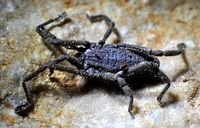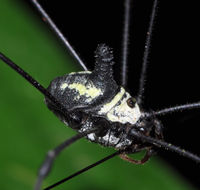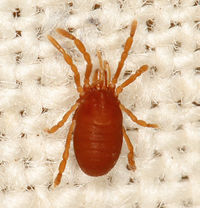Opiliones: Difference between revisions
| Line 62: | Line 62: | ||
== Noted == | == Noted == | ||
Although daddy harvest men are a fascinating group of arachnids the dramatic increase in environmental | Although daddy harvest men are a fascinating group of arachnids, the dramatic increase in environmental disturbances around the world, especially in tropical regions, may have driven many species to extinction even before the formal descriptions by taxonomists. Human activities including pesticide use, forestry operations, air and soil pollution, fire, and even the introduction of domestic animals have a tremendous impact on the habitats they depend on. All the formerly considered endangered were cave dwellers who are particularly sensitive to disturbances of habitat (Pinto-da-Rocha et al.2007). | ||
Contrary to popular belief daddy-long legs species do not contain the world's most powerful venom or any at all for that matter! | Contrary to popular belief daddy-long legs species do not contain the world's most powerful venom or any at all for that matter! | ||
[https://www.burkemuseum.org/blog/myth-daddy-longlegs-would-be-deadly.] | [https://www.burkemuseum.org/blog/myth-daddy-longlegs-would-be-deadly.] | ||
Revision as of 10:38, 21 April 2019
Common Names
Opiliones are commonly referred to as harvest men, but are also known as daddy long legs, granddaddy long legs, harvest spiders, shepherd spiders, or Phalangids. Opiliones were once scientifically classified as Phalangida, which you may see used in older literature. The more common name "daddy long legs" may also be mistakenly used to refer to the unrelated crane fly (Tipulidae) and the cellar spider (Pholcidae).[1]
Description
Opiliones are delicate, shy forms, and are among the largest of arachnids in woodlands (Coleman 2018). Opiliones can be differentiated from spiders by looking closely at what appears to be one body segment, but is actually two fused segments. Daddy long-legs do not possess silk glands, and can't spin webs. Unlike spiders, harvest men lack venom glands associated with their chelicerae. True of all arachnids, fertilization is by direct contact with female. Males of most taxa possess a penis, which is also referred to as a pene, or an aedagus. [2]
Harvest men are known for their exceptionally long walking legs compared to body size, although some species do have shorter legs. In more advanced species of harvest men, the first five abdominal segments are often fused into a dorsal shield called the scutum, which is normally fused with the carapace. Sometimes this shield is only present in males.They have a second pair of legs that are longer than the others and work as antennae. This can be hard to see in short-legged species.
Typical body lengths do not exceed 7 millimeters, with some species smaller than one millimeter. The largest species Trogulus Torosus can reach a length of 22 millimeters (Pinto-da-Rocha et al. 2007). Leg spans are much larger and some species can exceed 160 millimeter. [3]
Range and Habitat
Opiliones are found globally with the exception of Antarctica.
Forests, grasslands, wetlands, mountains, caves, chaparral, and even human dwellings make for suitable Opilione habitats.
Tropical systems hold the most Opilione species. The neo-tropics and Indo-Malayan are the most diverse realms with respectively 2691 species (41%) and 1337 species (20%). These two tropical regions are then home to almost 2/3 of the Opiliones. The third most diverse realm is the pale arctic with 819 species (13%), mostly because of its sheer size. The African tropics have 745 species (11%). Australasia with 564 species has 9% and Ne-arctic with 379 species has less than 6%. The total sum of species of all realms is slightly different from the total Opiliones because a few species are shared between regions [4]
Species
45 families are arranged into 4 suborders (of which Laniatores is by far the largest, with >4100 species) [5]
Suborders




There are an estimated 6600 species worldwide. of 4 suborders
Laniatores
Stout, spiny Opiliones found in the tropics, which may reach very large sizes.
Dyspnoi
Are temperate old world species, dull-colored and short-legged. Some species may have odd ocular ornamentation.
Eupnoi
These are the Opiliones familiar to Europeans and Americans that have earned them the order the name daddy long legs. Their legs are often very thin and long. Several of the tropical species ex. Gagrellinae, may have metallic shines, intricate honeycomb patterns of vascular tissues, and striped/dotted multicolored hues of blue, red, green, yellow.
Cyphophthalmi
These are the minute Acari like Opiliones. We lack much information on this sub order as they have not been studied until recently.[6]
Activity & Diet
Most species are nocturnal, although a number of diurnal species are known. Other species of the active predators are active during the daylight but most are known to be crepuscular (Coleman 2014). Species vary from omnivorous to predaceous and eat insects, vegetation and fungi, while some are also coprophagous.
Reproduction
Although parthenogenic species do occur, most harvest men reproduce sexually. Mating involves direct copulation. The males of some species offer a secretion from their chelicerae to the female before copulation. Sometimes the male guards the female after sex. The females lay eggs shortly after mating, or up to months later. Some species build nests for this purpose. A unique feature of some species are that the male is solely responsible for guarding the eggs resulting from multiple partners. Females often attempt to eat the eggs. The eggs can hatch anytime after the first 20 days, up to almost half a year after being laid. Daddy long legs need have about four to eight nymphal stages before reaching maturity, but six is the most common (Pinto-da-Rocha et al.2007).
Noted
Although daddy harvest men are a fascinating group of arachnids, the dramatic increase in environmental disturbances around the world, especially in tropical regions, may have driven many species to extinction even before the formal descriptions by taxonomists. Human activities including pesticide use, forestry operations, air and soil pollution, fire, and even the introduction of domestic animals have a tremendous impact on the habitats they depend on. All the formerly considered endangered were cave dwellers who are particularly sensitive to disturbances of habitat (Pinto-da-Rocha et al.2007). Contrary to popular belief daddy-long legs species do not contain the world's most powerful venom or any at all for that matter! [7]
References
Coleman, David C., et al. Fundamentals of Soil Ecology. Academic Press, 2018. Template:ISBN 978-0-12-805251-8
Pinto-da-Rocha, Ricardo, et al. Harvestmen: the Biology of Opiliones. Harvard University Press, 2007.
Opiliones. (2018, December 21). New World Encyclopedia, . Retrieved 21:30, April 20, 2019. https://www.newworldencyclopedia.org/p/index.php?title=Opiliones&oldid=1016769.
Bartlett, Troy. “Order Opiliones - Harvestmen.” Order Opiliones - Harvestmen - BugGuide.Net, 16 Feb. 2004, bugguide.net/node/view/2405#id. https://bugguide.net/node/view/2405#id
Kury, Adriano. (2013). Order Opiliones Sundevall, 1833. Zootaxa. 3703. 27-33. https://www.researchgate.net/publication/293635734_Order_Opiliones_Sundevall_1833
“Myth: Daddy-Longlegs Would Be Deadly but...” Burke Museum, 8 Apr. 2016, https://www.burkemuseum.org/blog/myth-daddy-longlegs-would-be-deadly.
Kury, A.B. (2000 onwards) Classification of Opiliones. Museu Nacional/UFRJ website. Online at: http://www.museunacional.ufrj.br/mndi/Aracnologia/opiliones.html